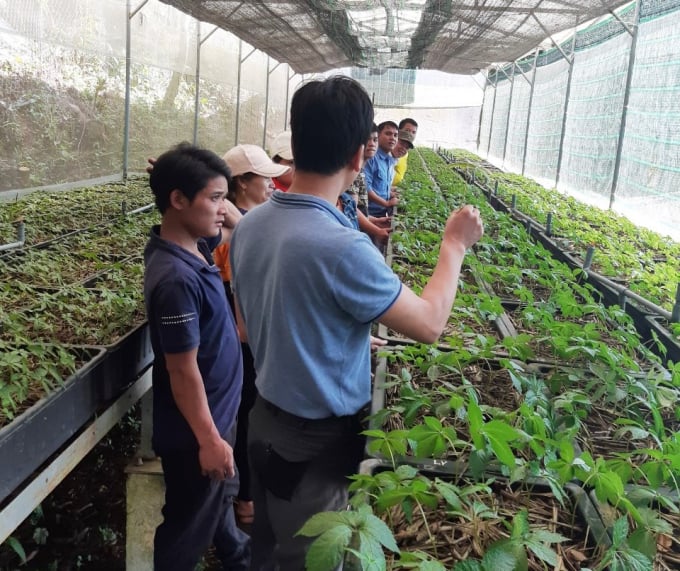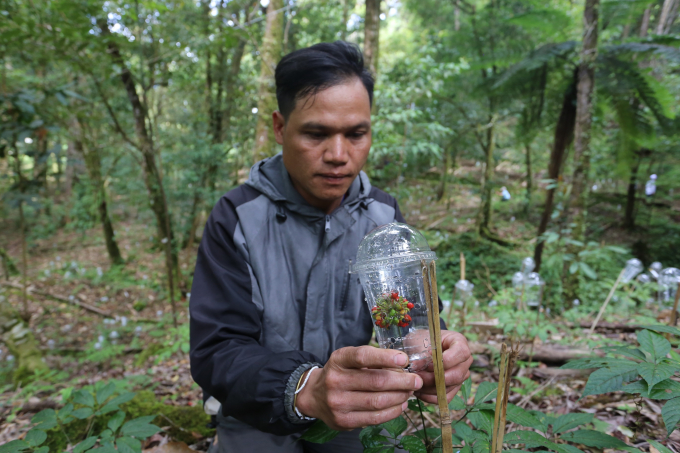November 21, 2025 | 14:39 GMT +7
November 21, 2025 | 14:39 GMT +7
Hotline: 0913.378.918
November 21, 2025 | 14:39 GMT +7
Hotline: 0913.378.918

Current measures for controlling pests and diseases on Ngoc Linh ginseng applied in the nursery still have very low efficiency. Photo: L.K.
Ngoc Linh ginseng is a special medicinal plant of the high mountain areas on the Ngoc Linh mountain range. It was found in 1973 in the Ngoc Linh mountainous area of Dak To District, Kon Tum Province, and Nam Tra My District, Quang Nam Province.
According to experimental research by scientists, Ngoc Linh ginseng not only has typical pharmacological effects of the genus Ginseng, but also of other significant pharmaceutical functions such as anti-stress, anti-depression, immune system stimulation, and anti-inflammatory toxins that damage cells…
At a national conference on the development of Vietnamese herbal medicines, the Prime Minister emphasized that Ngoc Linh ginseng must be considered as a precious national treasure and it is necessary to preserve, develop and strengthen research as well as apply it to treatment and health care activities.
Ngoc Linh Ginseng is characterized by a slow growth under the canopy of wet forests and rich plant composition. Currently, natural ginseng has been gradually exhausted. Therefore, to meet the market and business demands, farmers have started to grow it in concentrated planting areas, with strict intervention and control.
In fact, in recent years, a number of researches on breeding techniques and farming methods have achieved certain success and effectively applied to production. This has contributed to the effective and sustainable development of ginseng ensuring suitable ecological conditions for its growth.

Farmers are trained on pest control for Ngoc Linh ginseng. Photo: L.K.
Despite that, only some researches on pest control have been done. Current prevention measures have not yet brought about desired results. Some plant protection drugs have been tested by farmers in preventing pests and diseases for seedlings in nurseries, but they are almost ineffective or have very low effectiveness.
With the aim to select and develop some measures to control pests and diseases for Ngoc Linh ginseng in a biological, effective, and sustainable direction as well as improve its yield and quality, the Institute Plant Protection in cooperation with Ngoc Linh Ginseng Development Center and Quang Nam Medicinal Materials has carried out a research project on the application of biological measures to control pests and diseases for Ngoc Linh ginseng in Quang Nam. The project is directed by Dr. Le Xuan Vi with the implementation period lasting from February 2019 to April 2021.
Accordingly, the project has determined the composition, biological characteristics, arising evolution, and assessment of the main pests and diseases’ harmful effects on Ngoc Linh ginseng. It has collected and selected 1-2 beneficial microorganisms in the growing area which have the potentials for producing and developing preventive probiotics products.
At the end of the implementation period, the project had identified 9 major pests and diseases on Ngoc Linh ginseng that can cause damage at both seedling and non-production stages. Among them, aphids (Neomyzus sp.), seedling death (P. glomerata), anthracnose (Colletotrichum acutatum), and rust (Pucinia sp.) are found the most common and dangerous diseases.

The use of biological products that have been studied and experimented with pest and disease prevention on Ngoc Linh ginseng will help the plants grow and develop well, with higher efficiency and productivity. Photo: L.K.
Along with determining the phylogenetic characteristics of these pests and diseases, the research team collected beneficial microbial strains and conducted some biological pest control experiments. The results showed that Bacillus subtilis and the antagonistic fungus Trichoderma sp. collected from ginseng growing areas have potentials for research and development of disease preventive biological products.
In particular, the project has developed a process for collecting, separating and selecting beneficial microorganisms. It has also created 10 liters of inoculant from Bacillus subtilis to serve for research and pilot implementation. The research team also conducted pest control experiments with probiotics.
Laboratory studies have been modeled on a scale of 2,000 plants, applying key pest control techniques. The effectiveness of aphid control is from 61.08% to 78.99%; Tree height in the model has increased from 0.1 - 0.8cm; The average number of seeds increased by 25.25%. The rate of infected plants and the rust index were significantly reduced.
Mr. Truong Cong Quang, Deputy Director of the Center for Development of Ngoc Linh Ginseng and Quang Nam Medicinal Materials, said that currently, the biological products made from the project are under the monopoly of the Plant Protection Institute, so the Center only applied in small scale areas to compare with others having not applied it.
Translated by Linh Nguyen

(VAN) Results from the Sustainable Durian Model Project in Dak Lak have confirmed the critical role of Yara Viet Nam in transferring advanced nutritional solutions to farmers.

(VAN) In Tuyen Quang province, livestock farmers have introduced effective models and innovative practices that significantly strengthen African Swine Fever prevention and control efforts.

(VAN) This is the study conducted by IRRI and Can Tho University on the rice straw value chain in Mekong Delta showing an economic potential of more than 6.6 trillion VND/year.

(VAN) By participating in cooperative economics, many farmers in Tay Ninh have overcome hardship, mastered clean dragon fruit cultivation techniques.

(VAN) The crossbreeding program in the former Binh Dinh province (now part of Gia Lai) has shown signs of decline, and urgent measures are needed to revive it and sustain past achievements.

(VAN) The agricultural sector agreed on a roadmap to pilot the MRV protocol and expand low-emission rice production from the 2025-2026 winter-spring crop.

(VAN) Agricultural extension officers in Quang Ninh do more than transmit knowledge; they have become a steadfast support system for farmers on the path to sustainable agricultural development.